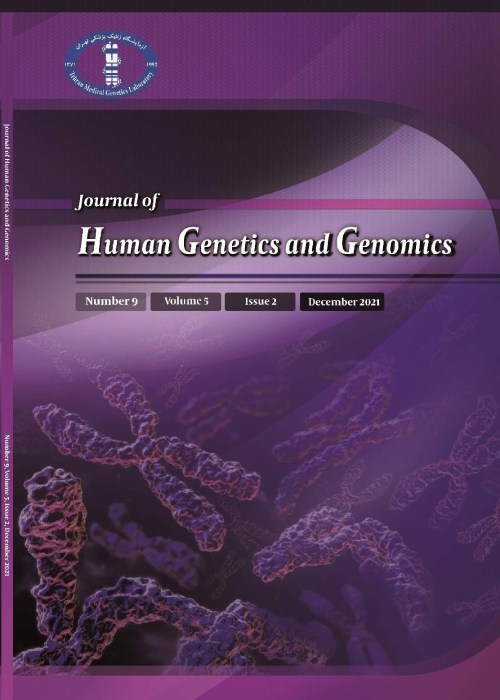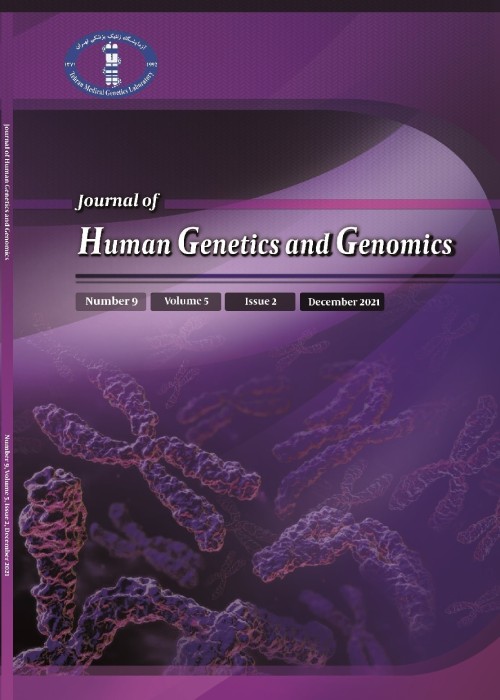فهرست مطالب

Journal of Human Genetics and Genomics
Volume:6 Issue: 1, Jun 2022
- تاریخ انتشار: 1402/04/05
- تعداد عناوین: 6
-
-
Page 1Background
Around 5% of tumors develop in the head and neck area, with nearly 50% of those appearing in the oral cavity. Oral cancer ranks as the sixth leading cause of cancer-related deaths. These figures illustrate the severity of the disease and emphasize the importance of raising awareness and providing early screening to detect and manage it. The treatment and prognosis of oral squamous cell carcinoma (OSCC) remain a significant challenge. This highlights the need for more effective treatments and strategies to improve the prognosis for individuals diagnosed with OSCC. In recent years, there has been significant progress in using microRNAs (miRNAs) as diagnostic and prognostic markers for cancer, making them a highly useful and valuable tool.
MethodsFor this research, we cultured and maintained cell lines for hypopharyngeal cancer (FaDu), oral cancer (Cal 27), and PDL cells. We then used quantitative real-time polymerase chain reaction (qRT-PCR) to confirm the expression levels of the potential biomarker, has-miR-556-5p
ResultsDuring the discovery phase, we identified hsa-miR-556-5p as being differentially expressed, with a statistically significant increase in its expression level. More recently, we used real-time PCR to confirm that hsa-miR-556-5p is markedly up-regulated in oral squamous cell carcinoma (OSCC). Our study suggests that hsa-miR-556-5p has the potential to be a new and innovative biomarker for OSCC.
ConclusionsThe candidate miRNA can be chosen as a promising biomarker for predicting patient outcomes and even for early detection of the disease in clinical settings.
Keywords: Oral squamous cell carcinoma, Hsa-miR-556-5p, real-time PCR -
Page 2Background
Cytokine storm is an aberrant response from the host immune system, and a main responsibility for the incidence of acute respiratory distress syndrome. The existence of the virus induced cytokine has been linked to mortality in patients with COVID-19. The study was aimed to review the genes that role in cytokine storm as therapeutic targets in patients with COVID-19.We demonstrated the role of pro-inflammatory cytokines in conditions that are often associated with COVID-19. Hyperproduction of mostly pro-inflammatory cytokines such as, IFN-γ, IL-6, IL-1, TNF-α, and Chemokines, which target lung tissue preferentially, can significantly worsen the prognosis in almost all cases. Data about the cytokines in this disease will support the development of more useful COVID-19 patient management strategies. In the management of COVID-19 patients, targeting cytokines can decrease mortality and increase survival rates.
Keywords: COVID-19, Cytokine storm, Therapy, Genes -
Page 3Background
One of the common diseases in different societies is Parkinson's disease (PD), for which no suitable treatment has been found yet. Curcumin a natural compound has shown neuroprotective properties in many studies. Therefore, in this research, the administration of this compound to female mice was studied.
MethodsInduction of PD in mice was done by administering 2 mg rotenone, and then a Rotarod test was performed on female mice. Also, 50 mg/kg of curcumin was administered every day for 21 days and its effects were evaluated in PD mice. Finally, the expression levels of bax and bcl-2 were measured in the brain of female mice by RT-PCR technique. GraphPad Prism V.8 software was used for data analysis.
ResultsInduction of PD led to a decrease in the performance of mice in the Rotarod test. However, the administration of curcumin to these mice improved their performance. Also, overexpression of bax and downregulation of bcl-2 genes were observed in the brains of PD mice, to whom the administration of curcumin downregulated bax gene and overexpressed bcl-2 gene.
ConclusionCurcumin has neuroprotective effects in PD conditions, which can be attributed to the change in expressions of the bcl-2 family gene. More studies are needed in this field.
Keywords: Gene, Curcumin, Neuroprotection, RT-PCR -
Page 4Background and purpose
Proteus mirabilis is one of the most important causes of urinary tract infection (UTI) and an opportunistic pathogen that can cause infection, especially in the urinary tract and bladder, pyelonephritis or kidney stones, especially in people with catheters or people with abnormalities of urinary system. The pathogenicity of this bacterium is caused by several genes, and sulfonamides prevent the growth of these bacteria by inhibiting DNA synthesis. The purpose of this study is to investigate the pathogenic genes that cause sulfonamide antibiotic resistance in Proteus mirabilis isolated from urinary infections in Iran.
MethodsIn this study, biochemical tests were performed to confirm the identity of Proteus mirabilis bacteria and DNA extraction, and then multiplex PCR tests were performed to identify pathogenicity genes Fal and Urea and antibiotic resistance genes Sul1 and Sul2 using specific primers.
ResultsIn this research, biochemical tests confirmed the identity of the bacteria and the target strain and multiple resistance of the Proteus mirabilis strain was observed to several different types of antibiotics. In addition, Multiplex PCR verified that more than 90% of the isolated strains had pathogenic genes (91.7% Fal and 95% Urea gene) and more than 50% of the strains had antibiotic resistance genes (51.7% Sul1 and 56.7% Sul2).
ConclusionConsidering the excessive use of antibiotics worldwide and the increasing spread of antibiotic resistance, it is better to check the pathogenic genes and their resistance to the antibiotics during the outbreak of the disease, consequently, the use of the antibiotics and their side effects must be reduced and to prevent the spread of antibiotic resistance.
Keywords: Proteus mirabilis, Multiplex PCR, Sul1, Fal, Urea, Sul2 -
Page 5Background
Retinitis pigmentosa is a heterogeneous genetic disorder with progressive degeneration of the retina leading to a progressive visual loss.
ObjectivesThe aim of this study was to identify the probable genetic cause of retinitis pigmentosa in 4 unrelated patients.
MethodsWhole exome sequencing was used to investigate the mutations.
ResultsWe found different variants in RP1L1, AIPL1, EYS and CRB1 genes including three novel and two previously reported mutations.
ConclusionsSince the disease has clinical and genetic heterogeneity, whole exome sequencing is the recommended method to find the disease causing mutations.
Keywords: Retinitis pigmentosa, Whole exome sequencing, Vision -
Page 6Background
One of the environmental factors leading to Alzheimer's disease (AD) is traumatic brain injury (TBI). Meanwhile, tau protein hyperphosphorylation is known as one of the mechanisms of AD development. In the present study, the effect of Rosa damascena and Ginkgo biloba aqueous extracts on tau hyperphosphorylation was studied on SH-SY5Y cell lines and mouse TBI models.
MethodsTau protein hyperphosphorylation was induced in SH-SY5Y cells using 10 μM retinoic acid (RA). Then, cells were treated with 500 and 1000 μg/ml aqueous extracts of Rosa damascena and Ginkgo biloba. Cell viability was studied by MTT test and tau protein hyperphosphorylation was studied by western blot and immunostaining techniques. Also, after the induction of TBI by pneumatic cylinder, mice were treated with 500 and 1000 μg/ml aqueous extracts of Rosa damascena and Ginkgo biloba, and the animals were tested for beam balance and walk tests to measure balance and muscle stiffness. Finally, tau protein hyperphosphorylation in the brain was investigated using an immunostaining technique.
ResultsBoth aqueous extracts of Rosa damascena and Ginkgo biloba were able to improve SH-SY5Y viability. Also, a decrease in phosphorylated tau protein was observed in cells treated with aqueous extracts of Rosa damascena and Ginkgo biloba. Performance improvements in beam balance and walk tests in TBI mice treated with 1000 μg/ml Rosa damascena and Ginkgo biloba aqueous extracts were seen. Also, tau protein phosphorylation was significantly decreased in the brain of TBI rats treated with those aqueous extracts.
Conclusionaqueous extracts of Rosa damascena and Ginkgo biloba have neuroprotective effects and are beneficial in reducing TBI-induced tau protein hyperphosphorylation, and they can prevent tau pathology.
Keywords: Extract, Hyperphosphorylation, Mouse, Tau. Alphabetical order


